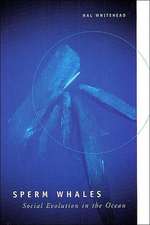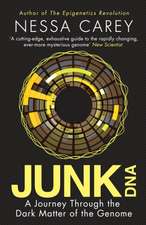Quantifying Life: A Symbiosis of Computation, Mathematics, and Biology
Autor Dmitry A. Kondrashoven Limba Engleză Paperback – 4 aug 2016
Since the time of Isaac Newton, physicists have used mathematics to describe the behavior of matter of all sizes, from subatomic particles to galaxies. In the past three decades, as advances in molecular biology have produced an avalanche of data, computational and mathematical techniques have also become necessary tools in the arsenal of biologists. But while quantitative approaches are now providing fundamental insights into biological systems, the college curriculum for biologists has not caught up, and most biology majors are never exposed to the computational and probabilistic mathematical approaches that dominate in biological research.
With Quantifying Life, Dmitry A. Kondrashov offers an accessible introduction to the breadth of mathematical modeling used in biology today. Assuming only a foundation in high school mathematics, Quantifying Life takes an innovative computational approach to developing mathematical skills and intuition. Through lessons illustrated with copious examples, mathematical and programming exercises, literature discussion questions, and computational projects of various degrees of difficulty, students build and analyze models based on current research papers and learn to implement them in the R programming language. This interplay of mathematical ideas, systematically developed programming skills, and a broad selection of biological research topics makes Quantifying Life an invaluable guide for seasoned life scientists and the next generation of biologists alike.
With Quantifying Life, Dmitry A. Kondrashov offers an accessible introduction to the breadth of mathematical modeling used in biology today. Assuming only a foundation in high school mathematics, Quantifying Life takes an innovative computational approach to developing mathematical skills and intuition. Through lessons illustrated with copious examples, mathematical and programming exercises, literature discussion questions, and computational projects of various degrees of difficulty, students build and analyze models based on current research papers and learn to implement them in the R programming language. This interplay of mathematical ideas, systematically developed programming skills, and a broad selection of biological research topics makes Quantifying Life an invaluable guide for seasoned life scientists and the next generation of biologists alike.
Preț: 307.34 lei
Nou
Puncte Express: 461
Preț estimativ în valută:
58.82€ • 63.87$ • 49.41£
58.82€ • 63.87$ • 49.41£
Carte tipărită la comandă
Livrare economică 22 aprilie-06 mai
Preluare comenzi: 021 569.72.76
Specificații
ISBN-13: 9780226371764
ISBN-10: 022637176X
Pagini: 418
Ilustrații: 90 halftones
Dimensiuni: 152 x 229 x 30 mm
Greutate: 0.64 kg
Ediția:1
Editura: University of Chicago Press
Colecția University of Chicago Press
ISBN-10: 022637176X
Pagini: 418
Ilustrații: 90 halftones
Dimensiuni: 152 x 229 x 30 mm
Greutate: 0.64 kg
Ediția:1
Editura: University of Chicago Press
Colecția University of Chicago Press
Notă biografică
Dmitry A. Kondrashov is a senior lecturer in the Biological Sciences Collegiate Division at the University of Chicago, where he developed an introductory course in quantitative modeling for biology—the origins of Quantifying Life. As an applied mathematician with research interests in protein structures and computational biology, he brings firsthand knowledge of the application of quantitative methods to biological problems and a passionate belief that experience with coding and mathematical skills opens new doors for young biologists.
Recenzii
“Taking a rare modeling approach, Kondrashov covers all of the mathematics and computation that biology students need, simultaneously introducing readers to programming in R (or any language really) and focusing on computational examples. And the writing is outstanding, the best I’ve seen in a mathematics text. I love this book—I will use pieces of it in every class I teach.”
“Very exciting, especially for life science students and those who teach biology. There is a growing need for more quantitative understanding among life scientists, and the concepts and tools provided in Quantifying Life are exactly the types of tools the field needs. It includes many of the standard tools of modeling but places an emphasis on stochastic processes and computation, two topics less common to many introductory modeling texts. It is unique in its inclusion of Bayesian analysis, Markov models, the use of linear algebra techniques in modeling, and a strong programming component, all designed for students with very little mathematical background. Further, the exercises place a much-needed importance on analysis of results and not just memorization of facts. The conversational style, use of real-world and modern data and examples, and hands-on approach mixing biological and mathematical background with programming in R are fantastic.”
“Quantifying Life . . . is an intriguing addition to the literature because of its hybrid nature: it combines some approaches to study data typically addressed in textbooks of biostatistics with others that are usually found in textbooks of mathematical biology. This approach is useful because it allows students to understand links between issues that are generally discussed in separate courses and to develop a more open mind in the numerical analysis of biological data. . . . This book deserves a space in the bookcase of people that want an introductory text to mathematical modelling in life sciences.”
“The book has seventeen short chapters, each of which is meant to represent a week’s worth of material. Thus a big fraction of the book could be covered in a semester. Each chapter includes a bit of mathematics, necessarily quite elementary, some simple biological applications, and some computing exercises in R. The author is adamant that pencil-and-paper exercises are not enough; there has to be some computing. The students are not expected to know anything about R initially. The first exercises are extremely simple, and the complexity grows gradually as the students proceed through the book. By the end of the semester they should know a fair amount, which ought to serve them well in the future. . . . This looks to me like an improvement on the bio-calculus approach to educating biology students, and I hope this book proves to be a success.”
“A wonderful and highly readable text that has the potential to have a great impact on the early training of biology students. . . . Quantifying Life is the best source for biology students to begin their study of quantitative modeling. The strengths of Quantifying Life are its size, choice of content, accessibility, price, and perhaps above all its approach to computing. I am also very excited about the use of the R language over other software or programming languages. . . . If you are a serious student of biology, then I strongly recommend to you to read Quantifying Life. I also believe that this book is a valuable resource for mathematicians and other quantitative scientists that find themselves working with biologists. It may prove very helpful in communicating with their collaborators in the life sciences.”







